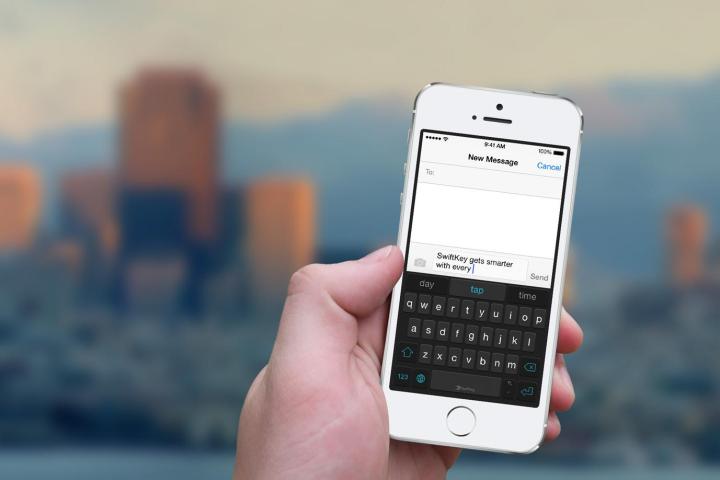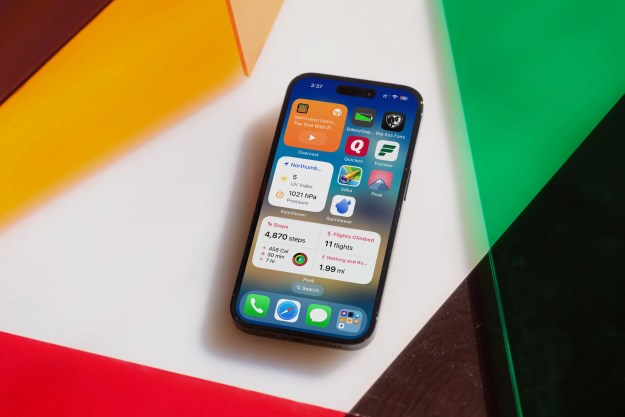
All three keyboard apps have a few bugs and lack the full functionality of their Android counterparts, but this is just the first version for all three app makers. We take a look at the highs and lows of each keyboard to determine a winner.
SwiftKey
SwiftKey is one of the most popular alternative smartphone keyboards around and for good reason. It combines great autocorrect, suggestions, and swipe-to-type functionality all in one attractive package. SwiftKey can also connect to your Facebook, Google, and Evernote accounts to offer more accurate predictions based on your history. The app learns how you type and tries to give you logical suggestions. Thanks to SwiftKey Cloud, all your typing patterns are saved and transferred onto any other device on which you use SwiftKey.
We found SwiftKey accurate and fast. Once we synced the app with our accounts, suggestions improved dramatically. Often, we only had to type the first letter of a word before the entire word popped up in the suggestions bar. Then, after tapping on the word, the next three words in the sentence appeared like magic. Using SwiftKey, we found that we barely had to type anymore.
Sometimes you just don’t want to type the same message you write to your mom every day again or you simply don’t feel like typing out every letter in the word “preposterous.” When you’re feeling lazy, SwiftKey will put the words right in your mouth or let you drag your finger along lazily to spell out that terribly long word.
The only downside of the iOS version, was that some features were limited and there are a few bugs. Sometimes, it takes a while for the keyboard to load, emoji aren’t built-in like they are on Android, and you’re limited to just two themes (for now). The Android app lets you choose between many different themes and even gives you the option to buy premium designs.
The iOS app also offers limited language support at the moment. SwiftKey’s Android app supports more than 60 languages and lets you add three different keyboards at a time, all of which you can use simultaneously. On iOS 8, you can only use two language keyboards at a time. While this probably doesn’t bother most people, it sure will tick off multilingual folks. However, SwiftKey told Digital Trends that this is only the first version of the keyboard for iOS 8 and assured us that many more updates, improvements, and new features are yet to come.
You can download it on the App Store for free.
Pros:
- Versatile input methods
- Accurate predictions
- Great for lazy typists
Cons:
- Limited variety of themes
- No built-in emoji support
- Limited language support
Fleksy
Fleksy’s claim to fame is a Guinness World Record for fastest smartphone keyboard. The keyboard is largely gesture-based and isn’t quite as intuitive as other apps, but it sure is fast once you get the hang of it. At first glance, Fleksy looks deceptively normal — it’s just a bunch of letters in QWERTY formation. But as you use it, the app corrects your spelling and adjusts to your typing patterns. To make the most of it, though, you’ll have to learn the gestures.
Fleksy’s app comes with a tutorial section, in which it explains how to type faster on the keyboard. If you want to delete a word, you simply swipe left. To add a space, you’ll need to swipe right. If you swipe twice, you’ll see punctuation options. Should you dislike the words Fleksy suggests to you, you simply swipe down to change the word. A variety of other swiping gestures are used to choose which word you meant to type and so on. Whenever you want to switch from one language to another, you just swipe left or right on the space bar.
However, most importantly, Fleksy has emoji built in. All you have to do is tap and hold the enter key to bring up all the emoji. Additionally, Fleksy offers 6 colorful themes for free and another 6 for those who are willing to pay. You can choose to have the space bar or not, as well as the size of your keyboard. The app currently supports 40 languages too.
We found Fleksy quite fast once we mastered the gestures, but it took a while to figure it all out. We found the suggestions less helpful that those SwiftKey offered and missed the swipe-to-type function. We did like the cosmetics of the app, though. The themes looked bright and fresh, the layout was very clean, and it was nice to have the option of making the keyboard larger or smaller whenever we wanted.
The language support is great and far surpasses SwiftKey at this stage. However, having to change between language keyboards all the time was kind of annoying. The presence of built-in emoji was one of the best parts about using Fleksy.
You can download it on the App Store now for $1.
Pros:
- Emoji integration
- Bright themes
- Adjustable size
Cons:
- Not intuitive
- Suggestions less helpful
- Have to switch keyboards to move between languages
Swype
Swype is — yep, you guessed it — a keyboard app that’s based on swipe-to-type gestures. Instead of clicking away on digital keys, Swype encourages you to slide your finger across the letters of each word. It’s a very straight forward app and there’s really no tutorial needed, even though Swype gives you one in its app menu. You can choose from five different themes and the keyboard supports several languages, including English, French, Italian, German, and Spanish.
As you swipe and type away, the suggestions at the top will prompt you to add words it doesn’t recognize to your personal dictionary. Once you’ve added all your weird terms and slang, it remembers that you consider “adorbs” a word the next time around. Every time you hit the space bar, Swype will try to predict what you’ll say next. After you’ve used the app for a while, it starts to pick up on your patterns and suggest better words. At first, Swype tends toward generic suggestions.
Like most keyboards, Swype offers autocorrect, the ultimate boon for bad spellers. It also features phrase correction, so if it sees you type the word “pit” it may think you mean “put” at first, but as soon as you add your next word, “bull,” Swype returns its correction to the original “pit.” We found this feature particularly helpful.
Overall, Swype was good at predicting what we wanted to say and it interpreted our swipes correctly — most of the time. To our eyes, the themes look a little bland and we missed emoji support. We did like the ability to switch between multiple language keyboards, but disliked having to choose which language we wanted to use all the time. Of the three, Swype is most similar to SwiftKey.
You can download it on the App Store now for $1.
Pros:
- Accurate swipe gestures
- Phrase correction
- Different themes
Cons:
- Bland themes
- No emoji support
- Limited language support
Winner
Keyboard preference is very personal and all three of these keyboards apps are truly great. We gladly give our stamp of approval for all three, even though there’s still a lot of work that needs to be done before these keyboard apps work perfectly on iOS devices. Fleksy seems the best prepared for the iOS 8 launch — its iOS and Android apps offer nearly the same functionality. Swype also seemed polished.
That said, the one I personally use is SwiftKey. SwiftKey offers most of my favorite features, including swipe gestures, auto correct, great suggestions, and effortless switching between languages.
What truly sets SwiftKey apart from the competition is SwiftKey Cloud. Having used the app before on multiple Android devices, the keyboard knew my typing habits from the get go. Its connection with my Gmail and Facebook accounts made its suggestions even more accurate than my typing data alone. Also, as someone who switches between English, Spanish, and German on the fly, I need a keyboard that can do the same. SwiftKey for iOS isn’t as masterful as it is on Android yet, but after a few updates, it will be well on its way.
Editors' Recommendations
- The 10 best photo editing apps for Android and iOS in 2024
- How to add a different home screen wallpaper on iOS 17
- The 7 biggest features we expect to see in iOS 18
- How to change your iPhone’s notification sound in iOS 17
- iOS 18 could add a customization feature I’ve waited years for
















